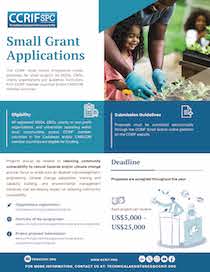July 24, 2009 -A collection of leading scientists, economists and analysts gathered on July 9 & 10 at the Economics of Climate Adaptation Summit in Ruschlikon, Switzerland to discuss how countries can implement climate adaptation. Hosted by the Swiss Re Centre for Global Dialogue, this gathering was part of the international preparations for Copenhagen 2009, the critical United Nations Climate Change Conference taking place in December.
Copenhagen 2009 is the last opportunity for the governments of the world to formulate a new protocol to address climate change before the Kyoto Protocol ends in 2012. Climate change exacerbates the impacts of hurricanes, increases rates of desertification, increases flooding and drought, and affects key industries such as tourism and agriculture.
At the Summit, Dr. Simon Young, CEO of CaribRM, the Facility Supervisor of the Caribbean Catastrophe Risk Insurance Facility (CCRIF), presented the Facility as a unique risk transfer agent, offering instruments that can be a key part of a country’s risk management framework, helping it to become more climate resilient. Standard climate adaptation strategies are typically not cost-effective for rare extreme events such as 1 in 100 year floods or droughts. Dr. Young stated that these events are not uninsurable as widely believed, and can be mitigated using risk transfer tools.
“The Caribbean governments who have nurtured CCRIF from a novel idea into a successfully operating and globally unique risk transfer solution have now placed that idea onto the global platform as a starting point for discussion and implementation of risk transfer as part of the overall climate change adaptation framework,” Dr. Young explained. “The idea resonates ever more strongly as the global community faces up to the changes in climate patterns and extreme events which we are already locked in to, and the challenges faced by the developing world in adapting to those changes in which they have played such a small part in causing.”
The CCRIF model combines public sector needs and donor/participant capitalisation with efficient access to the private reinsurance and capital markets, all within a not-for-profit structure benefiting the member countries (and therefore the region as a whole).
CCRIF’s participation in the Economics of Climate Adaptation Summit provided an opportunity for the voices and experiences of the Caribbean region to be integrated into the global discussion on hazard risk reduction and climate change. The innovative CCRIF model can be adapted for other small island states and would be a valuable addition to the new protocol on climate change.
About the CCRIF: The CCRIF is the first multi-country risk pool in the world, and is also the first insurance instrument to successfully develop a parametric policy backed by both traditional and capital markets. It is a regional insurance fund for Caribbean governments designed to limit the financial impact of catastrophic hurricanes and earthquakes to Caribbean governments by quickly providing financial liquidity when a policy is triggered. Sixteen governments are members of the fund: Anguilla, Antigua & Barbuda, Bahamas, Barbados, Belize, Bermuda, Cayman Islands, Dominica, Grenada, Haiti, Jamaica, St. Kitts & Nevis, St. Lucia, St. Vincent & the Grenadines, Trinidad & Tobago and the Turks and Caicos Islands. Last year the CCRIF paid out approximately US$6.3M to the Turks and Caicos Islands in the aftermath of Hurricane Ike.
Caribbean Risk Managers Ltd, the risk management arm of the CGM Gallagher Group, the Caribbean’s largest insurance broker, is the Facility Supervisor of the CCRIF.





